In the world of indoor gardening, harnessing the power of light is key to nurturing healthy, thriving plants. Among the various wavelengths in the light spectrum, blue light holds a special place due to its significant impact on plant growth and development.
This comprehensive guide delves into the science behind blue light, its benefits for indoor plant growth, and how to harness it effectively using LED grow lights. From promoting vigorous vegetative growth to enhancing nutrient content in crops, blue light offers a myriad of advantages to indoor gardeners.
Join us as we explore the wonders of blue light, and unlock its potential for cultivating thriving indoor gardens.
The Science Behind Blue Light and Plant Growth
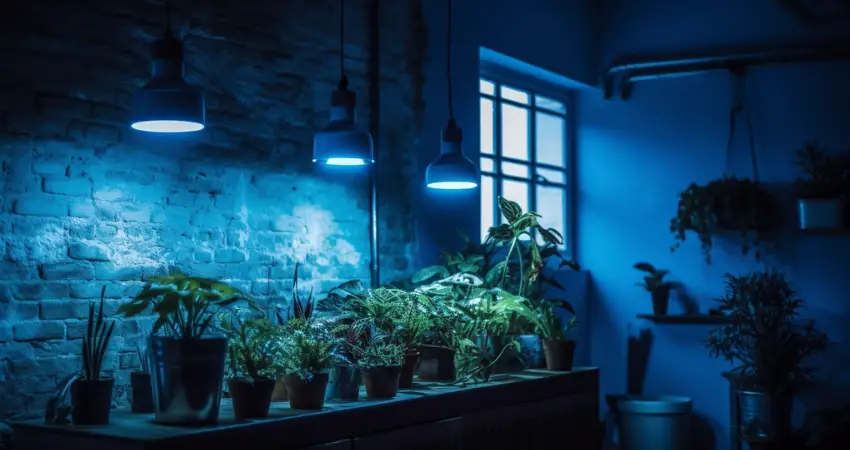
As we know, plants require light for photosynthesis, the process by which they convert sunlight into energy. This energy is used to produce carbohydrates from water and carbon dioxide. The key to this process is the absorption of light by chlorophyll, the green pigment found in plant cells.
Chlorophyll absorbs light most effectively in the red and blue regions of the spectrum. While red light is crucial for flowering and fruiting, blue light is particularly important for vegetative growth and overall plant health.
Photoreceptors in Plants
Plants possess special proteins called photoreceptors that detect and respond to specific wavelengths of light. Three main types of photoreceptors are involved in plant growth and development:
- Cryptochromes – sensitive to blue and ultraviolet (UV) light, they regulate growth, photomorphogenesis, and other light-dependent processes.
- Phototropins – primarily sensitive to blue light, they control phototropism, stomatal opening, and chloroplast movement.
- Phytochromes – sensitive to red and far-red light, they regulate germination, flowering, and shade avoidance response.
Benefits of Blue Light for Indoor Plant Growth
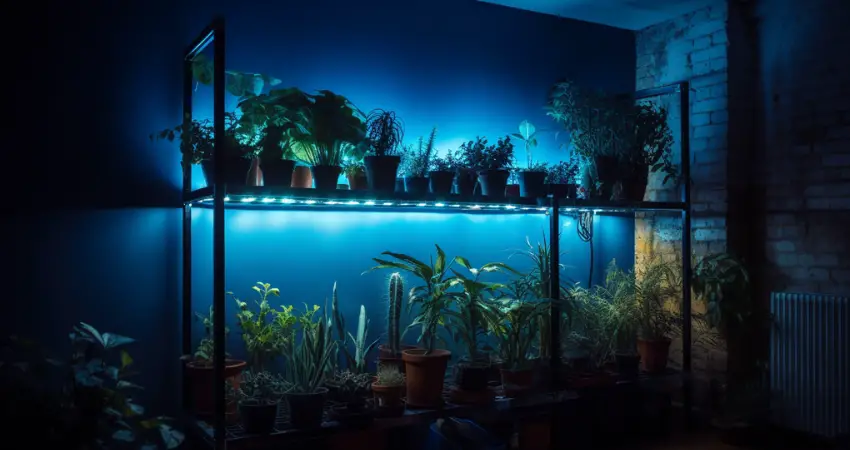
Enhanced Vegetative Growth
Blue light significantly impacts the vegetative growth of plants, which includes the growth of leaves, stems, and roots. Here’s how:
- Increased leaf size: Blue light stimulates the production of chlorophyll, which in turn leads to larger and healthier leaves.
- Enhanced stem growth: Exposure to blue light encourages the elongation of plant stems, resulting in taller, sturdier plants.
- Improved root development: Adequate blue light promotes robust root growth, allowing plants to better absorb water and nutrients.
Regulation of Photomorphogenesis
Photomorphogenesis refers to the changes in plant growth and development in response to light. Blue light plays a crucial role in several photomorphogenic processes:
- Phototropism: The movement of plants towards a light source, which is governed by phototropins, ensures optimal light exposure for photosynthesis.
- Shade avoidance response: When plants detect a lack of blue light due to shading from neighboring plants, they respond by elongating their stems and leaves to outcompete for light.
- Germination: Blue light triggers seed germination, a critical stage in a plant’s life cycle.
Improved Photosynthetic Efficiency
Blue light boosts photosynthetic efficiency in several ways:
- Increased chlorophyll production: Blue light promotes the synthesis of chlorophyll, which is essential for photosynthesis.
- Enhanced carbon dioxide uptake: With greater chlorophyll content, plants can absorb more carbon dioxide, improving their overall growth and health.
- Greater energy conversion rates: Blue light enhances the conversion of light energy into chemical energy, providing plants with the necessary fuel for growth and development.
Effects on Secondary Metabolites
Secondary metabolites, including antioxidants, are compounds that are not directly involved in a plant’s growth or reproduction but play essential roles in their defense, signaling, and overall health. Blue light exposure can influence the production of these compounds:
- Increased production of antioxidants: Blue light has been shown to increase the production of antioxidants such as flavonoids and carotenoids, which protect plants against environmental stress and pathogens.
- Enhanced nutrient content: Some studies suggest that blue light exposure can improve the nutrient content of certain crops, such as increasing the levels of vitamins and minerals in leafy greens.
- Improved flavor and aroma: Blue light can stimulate the production of aromatic compounds and volatile oils in herbs, enhancing their flavor and fragrance.
LED Grow Lights for Indoor Plant Growth
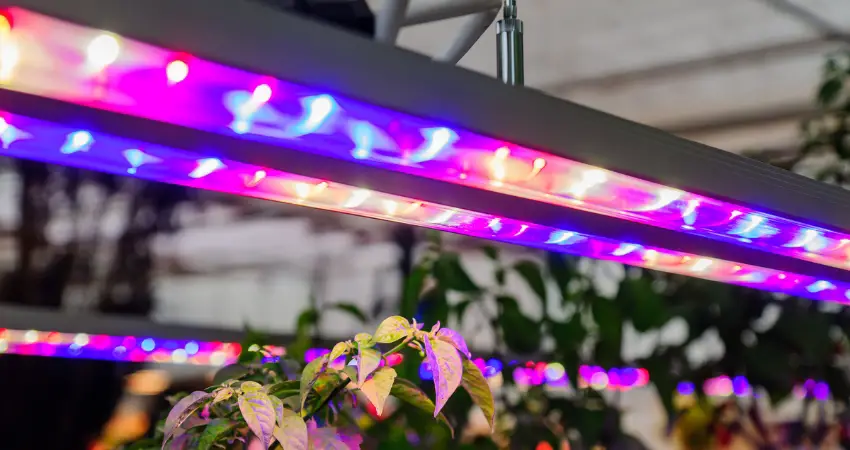
Advantages of LED Grow Lights
LED grow lights offer several benefits over traditional lighting solutions for indoor plant growth:
- Energy efficiency: LED lights consume less energy compared to other lighting options, making them an environmentally friendly and cost-effective choice.
- Longevity: LEDs have a longer lifespan than other lighting technologies, reducing the need for frequent replacements.
- Customizable light spectrum: LED grow lights can be designed to emit specific wavelengths of light, catering to the unique needs of different plant species and growth stages.
Types of LED Grow Lights
LED grow lights come in several forms, each with its own advantages:
- Full spectrum LED grow lights: These lights emit a balanced light spectrum that mimics natural sunlight, providing all the necessary wavelengths for optimal plant growth.
- Blue spectrum LED grow lights: These lights focus on the blue region of the spectrum, promoting vegetative growth and overall plant health.
- Adjustable spectrum LED grow lights: These lights allow users to fine-tune the emitted light spectrum, catering to the specific needs of various plant species and growth stages.
How to Choose the Right LED Grow Light
Selecting the appropriate LED grow light involves considering several factors:
- Understanding PAR and PPFD: Photosynthetically Active Radiation (PAR) refers to the range of wavelengths that plants use for photosynthesis. Photosynthetic Photon Flux Density (PPFD) measures the number of PAR photons reaching a given area per second. These metrics help determine the effectiveness of a grow light.
- Determining light intensity: Light intensity affects plant growth and development, so it’s essential to choose a grow light with the appropriate intensity for your plants and their growth stage.
- Consideration of plant species and growth stages: Different plants have varying light requirements, and these needs may change throughout their life cycle. Choose a grow light that meets the specific needs of your plants.
Examples of Blue Light Application for Indoor Plant Growth
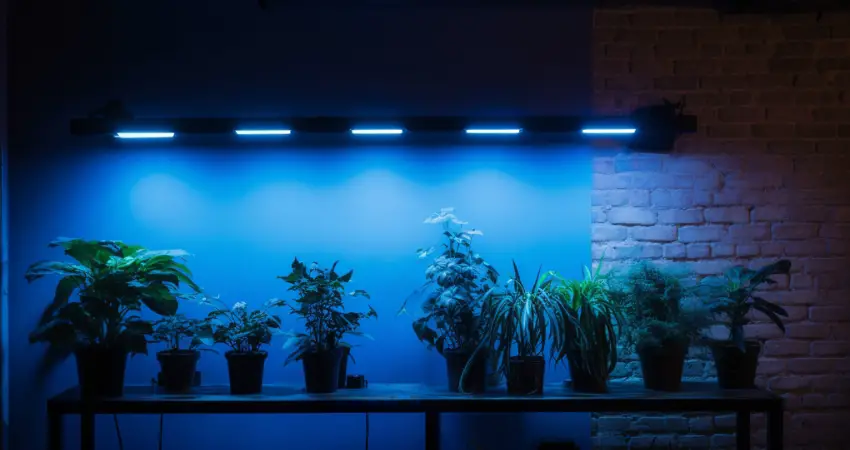
Commercial Agriculture and Blue Light
The use of blue light in commercial agriculture has led to significant advancements in crop production:
- Vertical farming: In vertical farming systems, blue light is used to promote plant growth and health in a controlled environment, maximizing crop yield and quality.
- Greenhouse cultivation: Supplementing natural sunlight with blue light in greenhouses can enhance crop growth, nutrient content, and overall productivity.
- Tissue culture propagation: Blue light is used in tissue culture propagation to promote the development of healthy plantlets, ensuring successful cloning and propagation efforts.
Home Gardening and Blue Light
Blue light also plays a significant role in home gardening, enhancing the growth of various plants:
- Indoor vegetable gardens: Blue light is crucial for growing healthy, nutrient-dense vegetables indoors.
- Indoor herb gardens: Blue light promotes the growth and potency of herbs, leading to better flavor and aroma.
- Ornamental plants and flowers: Blue light exposure results in healthier, more vibrant ornamental plants and flowers.
Potential Drawbacks and Concerns of Blue Light Exposure
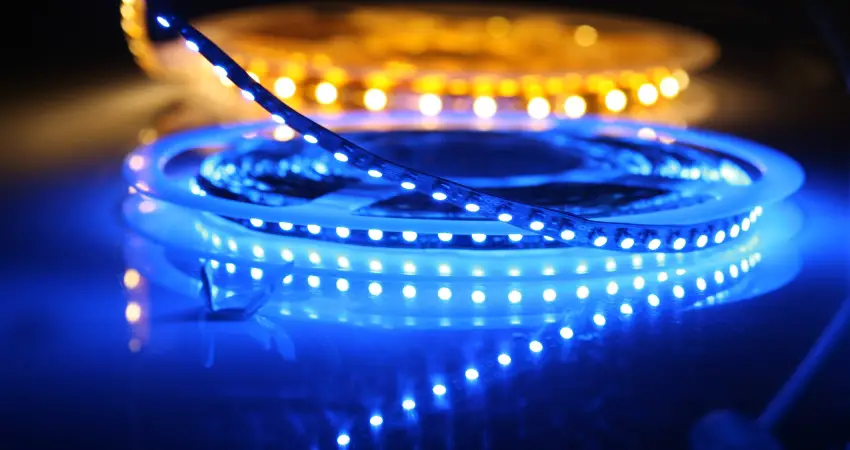
Photoinhibition and Photodamage
Excessive blue light exposure can lead to photoinhibition and photodamage in plants:
- Excessive blue light exposure: Overexposure to blue light can cause plants to become stressed and suffer from reduced photosynthetic efficiency, stunted growth, and other adverse effects.
- Preventing damage with proper light management: To avoid photoinhibition and photodamage, it’s essential to balance the light spectrum, intensity, and duration for each plant species and growth stage.
Human Health Concerns
Although blue light is beneficial for plants, it can have negative effects on humans:
- Blue light and sleep disruption: Excessive exposure to blue light, especially during the evening, can interfere with the human circadian rhythm and negatively impact sleep quality.
- Eye strain and damage: Prolonged exposure to blue light may cause eye strain, dryness, and potential long-term damage to the retina.
- Mitigation strategies for humans: To minimize the potential negative effects of blue light on humans, use protective eyewear, limit exposure to blue light-emitting devices, and maintain a safe distance from LED grow lights during operation.
Conclusion
The benefits of blue light for indoor plant growth are numerous, ranging from enhanced vegetative growth to improved nutrient content and flavor in crops. By understanding the science behind blue light and its effects on plants, as well as choosing the right LED grow lights, indoor gardeners can optimize their plants’ health and productivity. As we continue to explore the potential applications and advancements in blue light technology, the future of indoor plant cultivation looks promising. However, it’s crucial to balance the light spectrum, intensity, and duration to maximize these benefits while minimizing any potential drawbacks.
